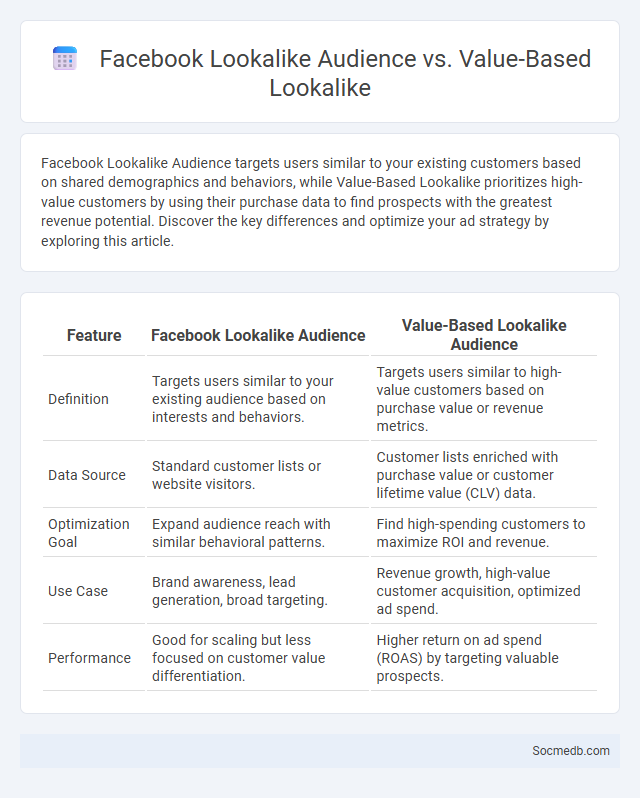
Photo illustration: Facebook Lookalike Audience vs Value-Based Lookalike
Facebook Lookalike Audience targets users similar to your existing customers based on shared demographics and behaviors, while Value-Based Lookalike prioritizes high-value customers by using their purchase data to find prospects with the greatest revenue potential. Discover the key differences and optimize your ad strategy by exploring this article.
Table of Comparison
| Feature | Facebook Lookalike Audience | Value-Based Lookalike Audience |
|---|---|---|
| Definition | Targets users similar to your existing audience based on interests and behaviors. | Targets users similar to high-value customers based on purchase value or revenue metrics. |
| Data Source | Standard customer lists or website visitors. | Customer lists enriched with purchase value or customer lifetime value (CLV) data. |
| Optimization Goal | Expand audience reach with similar behavioral patterns. | Find high-spending customers to maximize ROI and revenue. |
| Use Case | Brand awareness, lead generation, broad targeting. | Revenue growth, high-value customer acquisition, optimized ad spend. |
| Performance | Good for scaling but less focused on customer value differentiation. | Higher return on ad spend (ROAS) by targeting valuable prospects. |
Introduction to Facebook Lookalike Audiences
Facebook Lookalike Audiences enable you to reach new users who share similar characteristics with your existing customers, enhancing targeted advertising effectiveness. By analyzing data from your source audience, Facebook identifies high-potential prospects to expand your market reach efficiently. Utilizing Lookalike Audiences boosts campaign performance by increasing relevance and engagement rates.
What is a Standard Lookalike Audience?
A Standard Lookalike Audience is a Facebook Ads tool that enables advertisers to reach new users who share similar characteristics and behaviors with their existing customers or custom audiences. It is created by analyzing demographic data, interests, and online activity patterns from a source audience to find potential high-quality prospects with a comparable profile. This approach enhances targeting precision, increasing ad relevance and conversion rates in social media marketing campaigns.
Understanding Value-Based Lookalike Audiences
Value-based lookalike audiences leverage customer lifetime value data to identify and target users with the highest conversion potential on social media platforms. By analyzing top-performing customers' purchase behavior and engagement metrics, advertisers can create refined audience segments that drive higher ROI. This data-driven approach enhances campaign efficiency by prioritizing leads most likely to generate long-term revenue.
How Lookalike Audiences Work in Facebook Ads
Lookalike Audiences in Facebook Ads use your source audience data, such as Custom Audiences or pixel tracking, to identify new users who share similar characteristics and behaviors. Facebook's AI analyzes demographics, interests, and online activity to create a profile of potential customers that resemble Your best existing clients, increasing ad relevance and conversion rates. This targeted approach enhances campaign efficiency by reaching people most likely to engage with Your product or service.
Differences Between Standard and Value-Based Lookalikes
Standard lookalikes in social media advertising replicate audiences based on broad behavioral data, targeting users who resemble existing customers without considering their potential value. Value-based lookalikes prioritize high-value customers by integrating purchase data, enabling advertisers to focus on followers more likely to generate significant revenue. This approach enhances return on ad spend by aligning audience targeting with customer lifetime value and conversion quality.
Benefits of Using Standard Lookalike Audiences
Standard Lookalike Audiences on social media platforms significantly enhance your ad targeting by identifying users who closely resemble your existing customers, increasing the likelihood of engagement and conversions. Leveraging data-driven insights, these audiences help optimize ad spend by focusing on high-potential prospects, improving campaign efficiency and return on investment. Your marketing strategy benefits from expanded reach and precise targeting, driving stronger brand awareness and customer acquisition.
Advantages of Value-Based Lookalike Audiences
Value-based lookalike audiences on social media enhance advertising precision by targeting users who exhibit high-value behaviors similar to existing customers, increasing conversion rates and return on ad spend (ROAS). Leveraging data such as purchase frequency, cart value, and lifetime customer value allows marketers to create finely tuned audience segments for more effective campaign performance. This approach maximizes budget efficiency by prioritizing prospects with the highest potential for engagement and long-term loyalty.
When to Use Each Lookalike Audience Type
Use core lookalike audiences to reach new users closely matching your best existing customers, ideal for broadening reach without sacrificing relevance. Employ layered lookalikes when targeting a narrower group by combining multiple interest or behavior filters for higher precision and engagement. Select source-specific lookalikes when leveraging distinct customer segments or custom audiences, optimizing campaigns for conversion by mirroring proven high-value users.
Best Practices for Maximizing Lookalike Performance
To maximize lookalike audience performance on social media, leverage high-quality seed data such as your most engaged customers or highest-value transactions. Optimize targeting by segmenting audiences based on specific behaviors and demographics while regularly refreshing your seed lists to maintain relevance. Use platform-specific tools to A/B test different lookalike percentages and creative variations to continuously improve ad relevance and conversion rates for your campaigns.
Conclusion: Choosing the Right Lookalike Strategy
Selecting the optimal lookalike strategy hinges on identifying the most relevant seed audience that aligns with specific campaign goals and target demographics. Leveraging precise data inputs such as highest-value customers or recent converters enhances model accuracy and campaign ROI. Continuous testing and refining based on performance metrics ensure sustained engagement and conversion efficacy across diverse social media platforms.
 socmedb.com
socmedb.com